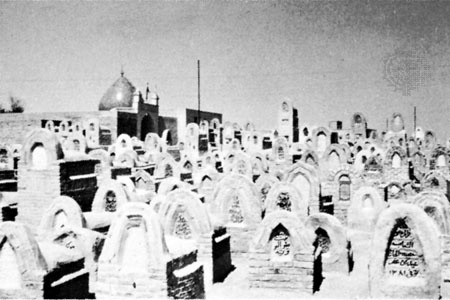Najaf, Al-
Iraq
also spelled Nejef, also called Mashhad ʿAlī
 city, capital of Al-Najaf muḥāfaẓah (governorate), central Iraq. Located about 100 miles (160 km) south of Baghdad, Al-Najaf lies on a ridge just west of the Euphrates River. It is one of Shīʿite Islam's two holy cities (the other being Karbalāʾ, also in Iraq) that is widely held to be the resting place of ʿAlī ibn Abī Ṭālib (Alīʿ)—Shīʿite Islam's most revered figure—whose tomb is located near the city's centre.
city, capital of Al-Najaf muḥāfaẓah (governorate), central Iraq. Located about 100 miles (160 km) south of Baghdad, Al-Najaf lies on a ridge just west of the Euphrates River. It is one of Shīʿite Islam's two holy cities (the other being Karbalāʾ, also in Iraq) that is widely held to be the resting place of ʿAlī ibn Abī Ṭālib (Alīʿ)—Shīʿite Islam's most revered figure—whose tomb is located near the city's centre.The caliph Hārūn al-Rashīd (Hārūn ar-Rashīd) is reputed to have founded Al-Najaf in AD 791; its growth occurred mostly after the 10th century. Because the city is home to the shrine (mashhad) of ʿAlī, it has remained a pilgrimage point for Shīʿite Muslims from throughout the world; it has also traditionally been the starting point of the hajj for pilgrims en route from Iran to Mecca. The tomb for which the city is famous is located near its centre. The dome of the shrine is plated with gold, and within it the walls and roof are covered with polished silver, glass, and coloured tiles. The resting place of ʿAlī is represented by a silver tomb with windows grated with silver bars and a door with a great silver lock. Inside is a smaller tomb of damascened ironwork. In the court in front of the dome are two minarets, which, like the dome, are covered with finely beaten gold upward from the height of a person to the top of each tower. The accumulated treasures of the shrine were carried off by Wahhābī raiders early in the 19th century. The building itself has also been damaged during periods of civil strife and warfare and has been rebuilt and renovated on numerous occasions.
In addition to its mosques, shrines, and religious schools, the city is known for its cemeteries. Outside the old city walls, over the barren sand plateau, stretch great fields of tombs and graves, for pious Shīʿites believe that Al-Najaf is so holy that to be buried there is to ensure entry into paradise. In addition to the city's population, there is frequently a large floating population of pilgrims, who sometimes bring the bodies of the deceased for interment or come with elderly and infirm family members who wish to live their last days in the holy city before being buried there. Political instability has sometimes interrupted the pilgrimage to the city, but during more-stable times the number of those visiting the city can, in the proper season, outstrip the local population.
Much of the city's encircling wall still remains, as do the deep sirdābs (vaulted cellars) that sometimes connect multiple houses and extend, in places, beyond the city's limits. These have provided both refuge from the midday sun and, often, sanctuary for political dissidents. Al-Najaf has long been a hotbed of Shīʿite resistance to the Sunni rulers in Baghdad, but during Iran's Pahlavi monarchy Al-Najaf was also a place of refuge for dissident Iranian Shīʿite clergy—notably Ruhollah Khomeini (Khomeini, Ruhollah), who lived and taught there for nearly 15 years. After the 1978–79 Iranian revolution, Shīʿite tension with Iraq's Baʿth government often centred on Al-Najaf, a circumstance that exacerbated relations between the governments of Iran and Iraq (given the large number of Iranian Shīʿite clerics in the city). A number of clerics were expelled after the Iranian revolution, and the Baʿthists arrested or killed numerous others during the Iran-Iraq War (1980–88). In quelling the insurrection that took place against the Iraqi government after the Persian Gulf War (1990–91), the Baʿthists killed many residents and Shīʿite leaders in Al-Najaf. (See Abolqasem al-Khoei (Khoei, Abolqasem al-).) During the Iraq War, the city had little involvement in the initial fighting but was later the scene of vigorous anti-coalition activity.
Al-Najaf governorate is a flat region extending from the Euphrates River in the northeast to the Saudi Arabian border in the southwest. Except for the area near the river, the region is sparsely populated. The governorate was created in 1976 from the western part of Al-Qādisiyyah and the eastern part of Karbalāʾ governorates. Area governorate, 11,129 square miles (28,824 square km). Pop. (1997 est.) city, 410,000; (2004 est.) governorate, 978,400.
- Schmidt, Mike
- Schmidt-Rottluff, Karl
- Schmidt telescope
- Schmidt, Wilhelm
- Schmitt, Florent
- Schmucker, S.S.
- Schnabel, Artur
- Schnabel, Julian
- schnauzer
- Schneider, Eugène
- Schneider, Hannes
- Schneider, Romy
- Schneider, Vreni
- Schneirla, Theodore Christian
- Schnitger, Arp
- Schnittke, Alfred
- Schnitzler, Arthur
- Schnorr von Carolsfeld, Julius
- Schnorr von Carolsfeld, Ludwig
- Schober, Johann
- Schoeck, Othmar
- Schoelcher, Victor
- Schoenberg, Arnold
- Schoenheimer, Rudolf
- Schoff, Hannah Kent